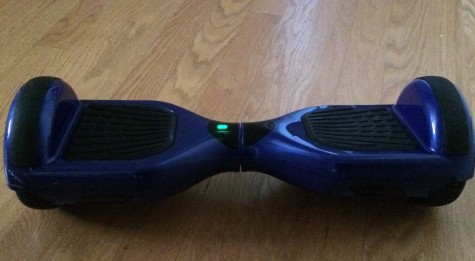Safely Hovering Into 2016
Hover boards were perhaps the most popular teen toy of 2015. Words that could be associated with these two wheeled self-balancing scooters include fun, addicting, and, unfortunately, explosive. Celebrities in magazines can be seen hovering their way downtown, and viral videos show dads falling off of these exciting toys. Because of their ever-increasing popularity, the chances are quite high that you know someone who has one. Despite the excitement of this trend, there is also a dangerous side. The news and social media have been filled with reports of these hover boards catching on fire. These safety issues have led to the recent implementation of regulations in California.

The most common and popular type of hover board. These teen toys have received negative press for their explosive batteries.
The hover board fires are sparking concern over the safety of this toy. The fires start in the lithium batteries when charging overheats the battery pack, igniting the fire. This battery issue has been around since 2006, when Sony recalled about 10 million laptop batteries that were overheating and burning their customers. There have been countless reports of hover boards catching on fire, motivating airlines to ban them and companies like Amazon to offer refunds and advise customers to get rid of them. Many families have decided to return hover boards that were gifted as Christmas presents this holiday season, including my own family. My little brother and future Wilcox student Vince Kloes shares, “though having a hover board would be exciting, I am okay with the fact that we returned it in order to stay safe.”
The “Hover Board Law” in California, while put into effect on January 1, 2016, was actually passed last year. It is formally referred to as California Assembly Bill 604 (AB604). In summary, the law states that these electrically motorized boards can only be used by those sixteen years of age or older accompanied with a helmet. They cannot be driven more than fifteen miles per hour, and it is a crime to ride them while under the influence of drugs or alcohol. A violation of these regulations will result in a $250 fine. One is also supposed to ride their hover board in the green bike lanes (like the ones on Calabazas by Wilcox). Sunnyvale Department of Public Safety Lieutenant Tracy Hern advises hover board riders, “not to ride at night because all the provisions needed to ride a bicycle at night (white light to the front visible for 300 feet, red light to the rear visible for 500 feet and yellow/white reflectors visible to the sides for 200 feet) are applicable to the hover board, or the rider.”
The implementation of these laws has made it slightly more difficult to ride freely, but also increases safety. Before the law was put into effect, freshman Juliana Hartley told me, “I never would have guessed that by 2015 I could be riding hands-free around the neighborhood.” It is pretty amazing to think that a similar idea used in the 1980’s movie, Back To the Future, is now a real method of transportation. Hover boards are frequently seen at Wilcox, even though they are not allowed. Wilcox Vice Principal, Ms. Henry informed me, “student safety is our main priority and now that new state laws are in place, it is even more important that we make sure they are not being used on campus to prevent injuries to our students.” That being said, if hover boards are used correctly, legally, and safely, they can be an effective way of getting around. Ms. Henry also expresses that, “another potential issue I see in a school setting is theft. Hover boards are expensive, and like any other item a student brings to school, we cannot be responsible for them.”
Though there are laws that change the way teens ride hover boards, there is no doubt that it is still a fun activity. It is a fun and quick way to get around the neighborhood. Students can safely ride them as long as they’re following the law. Perhaps in the future this problem can be solved with safer batteries that prevent overheating. These toys are hovering us into the future of transportation.










